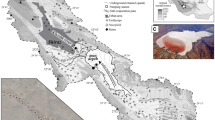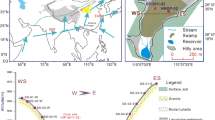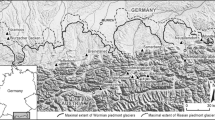Abstract
The ca. 13 m long sediment core PG1351, recovered in 1998 from the central part of Lake El’gygytgyn, NE Siberia, was investigated for lithostratigraphy, water content, dry bulk density (DBD), total organic carbon (TOC), total nitrogen (TN), total sulphur (TS) and biogenic silica (opal) contents, and for TOC stable isotope ratios (δ13CTOC). The event stratigraphy recorded in major differences in sediment composition match variations in regional summer insolation, thus confirming a new age model for this core, which suggests that it spans the last 250 ka BP. Four depositional units of contrasting lithological and biogeochemical composition have been distinguished, reflecting past environmental conditions associated with relatively warm, peak warm, cold and dry, and cold but more moist climate modes. A relatively warm climate, resulting in complete summer melt of the lake ice cover and seasonal mixing of the water column, prevailed during the Holocene and Marine Isotope Stages (MIS) 3, 5.1, 5.3, 6.1, 6.3, 6.5, 7.1–7.3, 7.5, 8.1 and 8.3. MIS 5.5 (Eemian) was characterized by significantly enhanced aquatic primary production and organic matter supply from the catchment, indicating peak warm conditions. During MIS 2, 5.2, 5.4, 6.2 and 6.4 the climate was cold and dry, leading to perennial lake ice cover, little regional snowfall, and a stagnant water body. A cold but more moist climate during MIS 4, 6.6, 7.4, 8.2 and 8.4 is thought to have produced more snow cover on␣the perennial ice, strongly reducing light penetration and biogenic primary production in␣the lake. While the cold–warm pattern during␣the past three glacial–interglacial cycles is probably controlled by changes in regional summer insolation, differences in the intensity of the warm phases and in the degree of aridity (changing snowfall) during cold phases likely were due to changes in atmospheric circulation patterns.
Similar content being viewed by others
References
Andersen KK, Azuma N, 47 co-authors (2004) High- resolution record of Northern Hemisphere climate extending into the last interglacial period. Nature 431:147–151
Asikainen CA, Francus P, Brigham-Grette J (2007) Sediment fabric, clay mineralogy and grain-size as indicators of climate change since 65 ka from El’gygytgyn crater lake, northeastern Siberia. J Paleolimnol DOI 10.1007/s10933-006-9026-5 (this issue)
Arkhangelov Y, Sher A (1978) The age of the permafrost in the far northeast of the USSR. In: Sander FJ (ed) USSR Contrib. Permafrost Second Intern. Conf., Yakutsk, USSR, 13–28 July 1993. Nat Acad Sci, Washington, DC, pp 155–159
Brigham-Grette J, Hopkins D (1995) Emergent marine record and paleoclimate of the last interglaciation along the Northwest Alaskan Coast. Quat Res 43: 159–173
Brigham-Grette J, Melles M, Glushkova O, Minyuk P, Belya B, Nowaczyk NR, Nolan M, Stone D, Layer P, Cherepanova MV, Forman SF (1999) Paleoclimate record of El’gygytgyn Crater Lake, NE Siberia – pilot cores extend to 200 ka. Paleoclimate from Arctic Lakes and Estuaries Newsletter, Vol. VII, Summer: 7
Cerling TE, Quade J (1993) Stable carbon and oxygen isotopes in soil carbonates. In: Swart P, Lohmann KC, McKenzie J, Savin S (eds) Climate change in continental isotopic records. AGU Monogr. 78, American Geophysical Union, pp 217–231
Chapman WL, Walsh JE (1993) Recent variations of sea ice and air temperature in high latitudes. Bull Am Met Soc 74:33–47
Cherepanova MV, Snyder J, Brigham-Grette J (2007) Diatom stratigraphy of the last 250 ka at El’gygytgyn Lake, northeast Siberia. J Paleolimnol DOI 10.1007/s10933-006-9019-4 (this issue)
Cohen AS (2003) Paleolimnology – The history and evolution of lake systems. Oxford University Press, 500 pp
Cremer H, Wagner B (2003) The diatom flora in the ultra-oligotrophic Lake El’gygytgyn, Chukotka. Polar Biol 26:105–114
Cremer H, Wagner B, Juschus O, Melles M (2005) A microscopical study of diatom phytoplankton in deep crater Lake El’gygytgyn, northeast Siberia. Algol Studies 116:147–168
Dansgaard W, Johnsen SJ, Clausen HB, Dahl-Jensen D, Gundestrup NS, Hammer CU, Hvidberg CS, Steffensen JP, Sveinbjörnsdottir AE, Jouzel J, Bond G (1993). Evidence for general instability of past climate from a 250-kyr ice-core record. Nature 364:218–220
Doran PT, Priscu JC, Lyons WB, Walsh JE, Fountain AG, McKnight DM, Moorhead DL, Virginia RA, Wall DH, Glow GD, Fritsen CH, McKay CP, Parsons AN (2002) Antarctic climate cooling and terrestrial ecosystem response. Nature 415:517–520
Glushkova OYu, Lozhkin AV, Solomatkina TB (1994) Holocene stratigraphy and paleogeography of El’gygytgyn Lake, northwestern Chukotka. 1994 Proc. Intern. Conf. Arctic Margins, Magadan, Sept. 6–10, Magadan, NEISRI FEB Russian Acad Sci, pp 75–80
Gore DB (1997) Blanketing snow and ice; constraints on radiocarbon dating deglaciation in East Antarctica. Ant Sci 9:336–346
Gurov YP, Gurova YP (1979) Stages of shock metamorphism of silicic volcanic rocks in the El’gygytgyn meteorite crater, Chukotka. Transactions (Doklady) of the USSR Acad. Sci.: Earth Science subsection 249:121–123 [in Russian]
Håkansson S (1985) A review of various factors influencing the stable carbon isotope ratio of organic lake sediments by the change from glacial to post-glacial environmental conditions. Quatern Sci Rev 4:135–146
Hawes I, Moorhead D, Sutherland D, Smeling J, Schwarz A-M (2001) Benthic primary production in two perennially ice-covered Antarctic lakes: patterns of biomass accumulation with a model of community metabolism. Ant Sci 13:18–27
Hecky RE, Campbell P, Hendzel LL (1993) The stoichiometry of carbon, nitrogen, and phosphorus in particulate matter of lakes and oceans. Limnol Oceanogr 38:709–724
Johnsen SJ, Clausen HB, Dansgaard W, Gundestrup NS, Hammer CU, Tauber H (1995) The Eem stable isotope record along the GRIP Ice Core and its interpretation. Quat Res 43:117–124
Kaufmann DS, Ager TA, 28 co-authors (2004) Holocene thermal maximum in the western Arctic (0–180°W). Quat Sci Rev 23:529–560
Keigwin LD (1998) Glacial-age hydrography of the far northwest Pacific Ocean. Paleoceanography 13:323–339
Kohzevnikov YuP (1993) Vascular plants in the vicinities of the Elgygytgyn Lake. In: Bely VF, Chereshnev IA (eds) The nature of the Elgygytgyn Lake Hollow (the problem of study and preservation). NEISRI FEB RAS, Magadan, pp 62–82 [in Russian]
Labeyrie L, Cole J, Alverson K, Stocker T (2003) The history of climate dynamics in the Late Quaternary. In: Alverson KD, Bradley RS, Pedersen TF (eds) Paleoclimate, global change and the future. Springer, Heidelberg, pp 33–61
Layer P (2000) Argon-40/argon-39 age of the El’gygytgyn impact event, Chukotka, Russia. Meteor Planet Sci 35:591–599
Lozkhin AV, Anderson PM (1995) The last interglaciation in Northeast Siberia. Quat Res 43:47–158
Lozkhin AV, Anderson PM, Matrosova TV, Minyuk P (2007) The pollen reord from El’gygytgyn Lake: implications for vegetation and climate histories of northern Chukotka since the late middle Pleistocene. J Paleolimnol DOI 10.1007/s10933-006-9018-5 (this issue)
Martinson DG, Pisias NG, Hays JD, Imbrie J, Moore Jr TC, Shackleton NJ (1987) Age dating of the orbital theory of the Ice Ages: development of a high-resolution 0 to 300,000-year chronostratigraphy. Quat Res 27:1–29
Melles M, Kulbe T, Overduin PP, Verkulich S (1994) The Expedition Bunger Oasis 1993/94 of the AWI Research Unit Potsdam. In: Melles M (ed), The Expeditions Norilsk/Taymyr 1993 and Bunger Oasis 1993/94 of the AWI Research Unit Potsdam. Repts Polar Res. 148, pp 27–80
Meyers PA, Ishiwatari R (1995) Organic matter accumulation records in lake sediments. In: Lerman A, Imboden D, Gat J (eds) Physics and chemistry of lakes. Springer-Verlag, New York, pp 279–328
Minyuk PS, Brigham-Grette J, Melles M, Borkhodoev BYa, Glushkova O (2007) Inorganic geochemistry of El’gygytgyn Lake sediments (northeastern Russia) as an indicator of paleoclimatic change for the last␣250 kyr. J Paleolimnol DOI 10.1007/s10933-006-9027-4 (this issue)
Minyuk PS, Nowaczyk NR, Glushkova OYu, Smirnov VN, Brigham-Grette J, Melles M, Cherepanova M, Loshkin AV, Anderson P, Matrosova TV, Hubberten H, Belaya BV, Borkhodokev BYa, Forman SL, Asikainen C, Layer P, Nolan M, Prokein P, Liston G, Nantsinger R, Sharpton B, Niessen F (2003) The processes of post-depositional magnetization and characteristic changes of the Earth’s magnetic field and climate in the past. NEISRI FEB RAS 2003: 91–135 [in Russian]
Moore JJ, Hughen KA, Miller GH, Overpeck JT (2001) Little Ice Age recorded in summer temperature reconstruction from warved sediments of Donard Lake, Baffin Island, Canda. J Paleolimnol 25:503–517
Müller A (2001) Late- and postglacial sea-level change and paleoenvironments in the Oder Estuary, southern Baltic Sea. Quat Res 55:86–96
Müller PJ, Schneider J (1993) An automated leaching method for the determination of opal in sediments and particulate matter. Deep-Sea Res 40:425–444
Nolan M, Brigham-Grette J (2007) Basic hydrology, limnology, and meteorology of modern Lake El’gygytgyn, Siberia. J Paleolimnol DOI 10.1007/s10933-006-9020-y (this issue)
Nolan M, Liston G, Prokein P, Brigham-Grette J, Sharpton V, Huntzinger R (2003) Analysis of Lake Ice Dynamics and Morphology on Lake El’gygytgyn, Siberia, using SAR and Landsat. J Geophys Res 108(D2): 8062, doi:10.1029/2001JD000934
Nowaczyk NR, Frederichs TW, Kassens H, Nørgaard-Pedersen N, Spielhagen RF, Stein R, Weiel D (2001) Sedimentation rates in the Makarov Basin, central Arctic Ocean: s paleomagnetic and rock magnetic approach. Paleoceanography 16:368–389
Nowaczyk NR, Melles M, Minyuk P (2007) A revised age model for core PG1351 from Lake El’gygytgyn, Chukotka, based on magnetic susceptibility variations tuned to northern hemisphere insolation variations. J␣Paleolimnol DOI 10.1007/s10933-006-9023-8 (this issue)
Nowaczyk NR, Minyuk P, Melles M, Brigham-Grette J, Glushkova O, Nolan M, Lozhkin AV, Stetsenko TV, Anderson PM, Forman SL (2002) Magnetostratigraphic results from impact crater Lake El’gygytgyn, northeastern Siberia: a 300 kyr long high-resolution terrestrial palaeoclimatic record from the Arctic. Geophys J Intern 150:109–126
Overpeck JT, Hughen K, Hardy D, Bradley R, Case R, Douglas M, Finney B, Gajewski K, Jacoby G, Jennings A, Lamoureux S, Lasca A, MacDonald G, Moore J, Retelle M, Smith S, Wolfe A, Zielinski G (1997) Arctic environmental change in the last four centuries. Science 278:1251–1256
Paillard D, Labeyrie L, Yiou P (1996). Macintosh program performs time-series analysis. Eos Trans AGU 77:379
Polyakov IV, Alekseev GV, Bekryaev RV, Bhatt U, Colony RL, Johnson MA, Karklin VP, Makshtas AP, Walsh D, Yulin AV (2002) Observationally based assessment of polar amplification of global warming. Geoph Res Lett 29: 1878 10.1029/2001GL011111
Shilo NA, Lozhkin AV, Anderson PM, Belaya BV, Stetsenko TV, Glushkova OY, Brigham-Grette J, Melles M, Minyuk PS, Nowaczyk N, Forman S (2001) The first continuous pollen record of climate and vegetation change during the last 300,000 years. Doklady Akademia Nauk 376(2):231–234 [in Russian]
Shipboard Scientific Party (2005) Arctic Coring Expedition (ACEX): paleoceanographic and tectonic evolution of the central Arctic Ocean. IODP Prelim. Rept. 302. http://www.ecord.org/exp./acex/302PR.pdf
Siegert MJ, Dowdeswell JA, Melles M (1999) Late Weichselian glaciation of the Russian High Arctic. Quat Res 52:273–285
Smol JP (1988) Paleoclimate proxy data from freshwater arctic diatoms. Verh Intern Verein Limnol 23:837–844
Squyres SW, Andersen DW, Nedell SS, Wharton Jr RA (1991) Lake Hoare, Antarctica: sedimentation through a thick perennial ice cover. Sedimentology 38:363–379
Svendsen JI, Astakhov VI, Bolshiyanov DYu, Demidov I, Dowdeswell JA, Gataullin V, Hjort C, Hubberten H-W, Larsen E, Mangerud J, Melles M, Möller P, Saarnisto M, Siegert MJ (1999) Maximum extent of the Eurasian ice sheets in the Barents and Kara Sea region during the Weichselian. Boreas 28:234–242
Talbot MR, Lærdal T (2000) The Late Pleistocene–Holocene palaeolimnology of Lake Victoria, East Africa, based upon elemental and isotopic analyses of sedimentary organic matter. J Paleolimnol 23:141–164
Thiede J, Winkler A, Wolf-Welling T, Eldholm O, Myhre AM, Baumann K-H, Henrich R, Stein R (1998) Late Cenozoic history of the Polar North Atlantic: results from ocean drilling. Quat Sci Rev 17:185–208
Wilkin RT, Barnes HL (1997) Formation processes of framboidal pyrite. Geochim Cosmochim Acta 61:323–339
Yershov ED (1989) Geocryology of the USSR, Eastern Siberia and Far East. Nedra, Moscow, 515 pp [in Russian]
Acknowledgements
We would like to thank Pier Paul Overduin and Artur Zielke (Alfred Wegener Institute, AWI) for conducting the coring in spring 1998, and Ute Bastian (AWI) for laboratory assistance. Bernd Wagner (University Leipzig) is acknowledged for valuable comments on an earlier draft of this paper. Special thanks are due to Tom Edwards and two anonymous reviewers for their very helpful comments and suggestions. Financial support was kindly provided to MM and HWH by the German Federal Ministry for Education and Research (BMBF), grant no. 03G0586A, B and to JBG by the U.S. National Science Foundation (OPP Award #96-15768, Atmospheric Sciences Award 99-05813, and OPP Award #00-02643).
Author information
Authors and Affiliations
Corresponding author
Additional information
This is the seventh in a series of eleven papers published in this special issue dedicated to initial studies of El'gygytgyn Crater Lake and its catchment in NE Russia. JulieBrigham-Grette, Martin Melles, Pavel Minyuk were guest editors of this special issue.
Rights and permissions
About this article
Cite this article
Melles, M., Brigham-Grette, J., Glushkova, O.Y. et al. Sedimentary geochemistry of core PG1351 from Lake El’gygytgyn—a sensitive record of climate variability in the East Siberian Arctic during the past three glacial–interglacial cycles. J Paleolimnol 37, 89–104 (2007). https://doi.org/10.1007/s10933-006-9025-6
Received:
Accepted:
Published:
Issue Date:
DOI: https://doi.org/10.1007/s10933-006-9025-6




